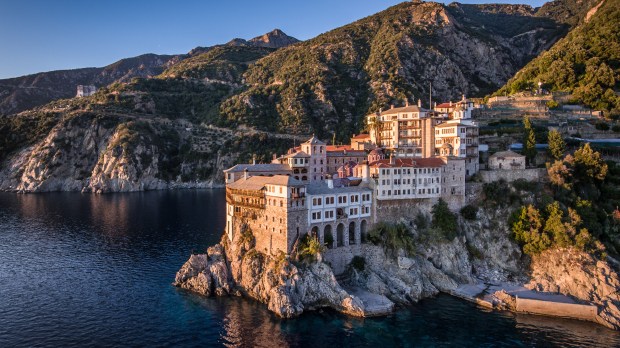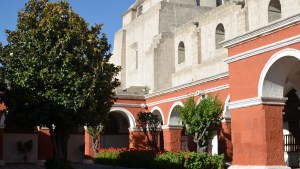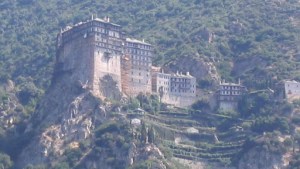As his native country is being rocked by war, a Ukrainian filmmaker is hoping that his film about ancient monastic life will help restore tranquility to a world “turned upside down.”
Where Are You, Adam? is Aleksandr Plyska’s documentary about life in one of the 20 monasteries on Mt. Athos in Greece – one of the most important centers of Orthodox monasticism. Plyska, a deacon in the Ukrainian Orthodox Church, produced the film after spending several long-term stays at the 10th-century Monastery of Docheiariou.
Reminiscent of Into Great Silence, the 2005 documentary about life in a Carthusian monastery, Where Are You, Adam? takes the viewer into the daily life of monks whose days are filled with communal and private prayer, work, hospitality for pilgrims, and recreation. The title is a reference to the expulsion of Adam and Eve from the Garden of Eden (Genesis 3:9-24).
“The Lord God then called to the man and asked him Where are you?”
“I heard you in the garden; but I was afraid, because I was naked, so I hid.”
The life of a monk focuses on returning to the state of Man before the Fall.
“Images of nature alternate with the monks’ almost ceaseless round of work and prayer, creating a rhythmic bond between man and the natural world that hints at a paradise we all dimly yearn for,” the film’s promotional material says. They “desire to regain for themselves a state akin to the humanity of Adam before the Fall.”
A hidden life
The monastery of Docheiariou takes as its heavenly patrons the Archangels Michael and Gabriel. It is home to the Gorgoepikoos icon – the Virgin Mary Quick-to-Hear [Prayers]. Plyska first visited in 2002 and said he was intrigued by the various “characters” he met there, and he began jotting down his observations.
“In my mind, I began having images of profiles or characteristics of these monks. It reminded me of characters from the lives of the saints of the Caves Monastery in Kyiv,” Plyska said in an interview. “I started putting this on paper but then I lost my notes. But then there was a thought that it would be better done by a film, because the cinema, like a piece of art, has this feature of making it possible for people to be engrossed in, to dive into, this environment. So since 2006, on an annual basis I try to spend an average of three months a year in this monastery.”
But he had to persuade the reluctant monks and their abbot, Gregorios Zumis, to allow him to bring in a film crew and expose their life to the world. Because Plyska was a regular pilgrim there, Abbott Gregorios finally gave his consent, on condition that the documentary not be a film about him and not merely “another advertisement” for Mt. Athos.
“The monastery is like any house or family. They’re trying to preserve themselves, their atmosphere, their values,” Plyska said. “The prohibition against filming is the means of making sure they don’t lose their authenticity, because if you allow everyone to film, people will stop coming.”
But Abbot Gregorios and the monks came to know and trust Plyska, who in turn hired Ukrainian director/cinematographer Oleksandr Zaporoshchenko.
“He approached this whole process very humbly with his head bowed down,” Plyska said of the director. “It’s fantastic how he managed to portray the pace, the rhythm of the monastery.”
After four years of work, ten trips to Mt. Athos, and 80 hours of filming, the documentary premeired in Europe in 2019. It’s been shown in about 12 countries so far, and Plyska and his team are trying to bring it to the U.S.
“To imagine that the grace of God will be pouring from the screen, I couldn’t even imagine when we started it,” Plyska exclaimed.
Abbot Gregorios was able to see the film and allowed a special screening for his monks before he died in 2018.
Athos’ meaning for the world
The Aegean peninsula where the 6,600-foot Mt. Athos sits is an autonomous part of Greece that is allowed to control its own immigration. Only men are allowed to visit, and of them, very few non-Orthodox men are given visas.
Plyska characterizes Athos as a vital element in the life of the Church and the world.
“Mt. Athos is the courage, the tears and the blood of people who have been living there for thousands of years,” he said. “Mt. Athos is the testimony for the fact that if God starts speaking with a man, man cannot decide not to hear. Mt. Athos is the testimony of man’s love for God, when man is sacrificing his whole life to God.”
And yet, his film was never meant to be a tool of “evangelization,” even for an increasingly secular age. Asked if he hopes it will reach people in a world that thinks less and less about God, Plyska said he would reframe the question, arguing that the West is actually not abandoning the sacred.
“We are simply witnessing the processes that happen in the life of a human being. In every person’s life you have moments that can be called the East and the West, the sunrise, the dusk, the dawn, the desert, the heat,” the deacon/producer said. “But the person cannot choke the breath of God inside himself. And the West will not be able to turn its face away from God for long.”
Plyska opines that today’s Church and society can do a better job in overcoming habits that “don’t allow for modern man to see God.”
“I think priests should be speaking only about God,” he said, to “give the person who comes to church instruments on how to talk with God, give him the possibility to feel God, to feel the breath of God. When that person goes out, be he an architect or an artist or a scientist, he will be applying this feeling of God in what he is doing in his life. And when the priest begins belaboring himself with politics, with environmentalist stuff and things that are secondary, the most important things get lost.”
He said that in today’s world, “we are making a lot of noise. We’re talking a lot these days. I’m kind of far from thinking that there can be evangelization, because I’m sure God is talking directly to every man. From that point of view, we just need to create tranquility, peace, silence. God himself is knocking. He’s not breaking through the door. He’s very polite. But the world today has turned upside down.”
Perhaps Where Are You, Adam? will help people learn how to create that vital silence in their own lives.



